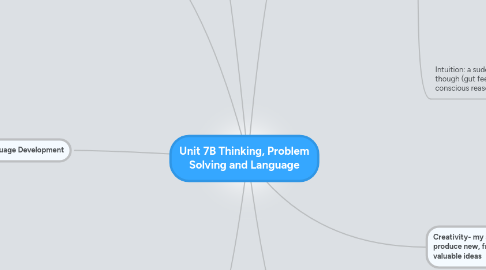
1. Thinking
1.1. Prototype: a mental image or example with features that I associate a category- for example, people would agree that a dog is a canine more quickly than that a wolf is a canine
2. Language: spoken, written or signed words that can be combined to make meaning
2.1. Phoneme: the smallest distinctive sound unit~ the alphabet is not the only phoneme, CH is a phoneme
2.2. Morpheme: the smallest unit that caries meaning (may be a word or part of a word like ed)
2.3. Grammar- system of rules in language that allow us to communicate and understand others
2.3.1. Semantics: set of rules we use to derive meaning from morphemes, words and sentences~ ex. -ed means happened in the past
2.3.2. Syntax: rules we use to order words in sentences~ ex. adjectives usually come before nouns
3. Language Development
3.1. Babbling stage: at about four months, infants suddenly utter various sounds that's unrelated to usual language
3.2. One-word stage: from age 1-2, a child mostly speaks single words
3.3. Telegraphic speech/ Two-word stage: at about age two or more, child speaks two-word sentences that sounds like a telegram like "go car" (NOUN+VERB)
3.4. Explanations of Language Development
3.4.1. Operant Learning: can explain language development with association (associate an image or object with word), imitation ("say ma and pa", and reinforcement (smile at a baby when they say something correct)
3.4.2. Inborn Universal Grammar: all human languages have the same grammatical building blocks like nouns and verbs~ we start speaking in nouns rather than verbs/adjectives
3.4.3. Critical Period: childhood is a critical period for mastering certain aspects of language~ when this closes, learning a second language seems more difficult
3.4.4. Statistical Learning: babies can discern word breaks and statistically analyze which syllables most often go together~ ex. 8 month listens to an unbroken, monotone string of nonsense syllables- the baby can recognize the three-syllable sequence
4. Thinking and Language
4.1. Bilingual Advantage: bilingual children who learn two languages at the same time have an advantage in attention and cognitive control because I refrain/inhibit one language when using another~ ex. I am not using Korean when I speak English
4.2. Linguistic determinism: language determines the way we speak~ ex. The Hopi (Native Americans) have no past tense for verbs, therefore a Hopi could not easily think about the past
4.3. Theories of Language Learning and Thinking...
4.3.1. Personality: language influences our personality and the way we think; ex. when using English, bilingual speakers expressed more extraverted, agreeable and conscientious selves
4.3.2. Numbers: ex. if my language only has words for numbers 1 and 2, it would be difficult to describe something more than 2.
4.3.3. Color: if my language only has one word to describe yellow, while my friend's language has two words to describe different shades of yellow, my friend would be better able to recognize the distinctions in yellows
5. Problem Solving
5.1. Algorithms: step-by-step method that guarantees a solution, but it takes a long time and a lot of effort- ex. in order to find the combination to a lock, I could try all the different combinations
5.2. Heuristics: simpler strategy where I make judgements to make problem solving more efficient~ faster but more likely to make an error compared to algorithms- ex. in lock example, I try out the lock owner's birthdate
5.2.1. Representativeness Heuristic: judge the likelihood of things according to how well they seem to represent certain prototypes- ex. doctor is MOM, not DAD example in class- think of males as doctors
5.2.2. Availability Heuristic: estimate likelihood of event according to how much info is available to us- ex. we think plane crashes are more common than it is because of news that's available to us
5.3. Insight: sudden and novel realization of the answer to the problem (eureka!)~ contrasts with strategy-based solutions
5.4. Obstacles to Problem Solving
5.4.1. Confirmation Bias: I search for info or hints that support my initial preconceptions while ignoring contradicting evidence
5.4.2. Fixation: I'm unable to see a problem from a new perspective (I am not OPEN)
5.4.2.1. Mental Set: predisposes how we think~ I approach a problem or think a particular way, a way that was probably successful in the past~
5.4.2.2. Functional Fixedness: I think of things only in terms of their usual functions- ex. I can't think of the fact that I can use my textbook as a dumbbell
5.4.3. Overconfidence: I tend to be more confident in something rather than be correct at it~ ex. overestimate my test scores cause I study three hours (don't use time effectively)
5.4.4. Belief Perseverance: I cling to my initial beliefs even though the basis in which my judgement was made is proven wrong
5.4.5. Framing: the way an issue, problem or question is proposed; the way it's proposed could influence our judgement and opinions
5.5. Intuition: a sudden and automatic feeling or though (gut feeling) rather than a explicit and conscious reasoning
6. Creativity- my ability to produce new, fresh and valuable ideas
6.1. Sternberg's Five Components of Creativity: factors needed for creativity
6.1.1. Expertise: I have a well-developed base of knowledge needed to be creative
6.1.2. Imaginative thinking skills: ability to see things in a new way and to recognize+connect patterns
6.1.3. Venturesome personality: be unafraid to try new things and seek new experiences; tolerate mysteriousness and risk
6.1.4. Intrinsic motivation: driven by interest, satisfaction and challenge rather than something extrinsic like money
6.1.5. Creative environment: a place where ideas can spark in your head~ THINK GOOGLE
6.2. Convergent Thinking: thinking that's required for intelligence tests that demands a single correct answer
6.2.1. Parietal Lobe: injury to the left parietal lobe damages the convergent thinking required for intelligence tests.

